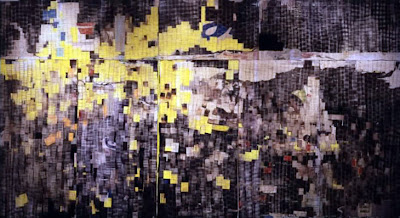Eleanor Antin and Judy chicago in California Get the scoop in this article in Flash art magizine.
http://www.flashartonline.com/interno.php?pagina=articolo_det&id_art=884&det=ok&title=ELEANOR-ANTIN-JUDY-CHICAGO
A place to share reviews of artworks, exhibitions and other tidbits for students in the MFA Studio Art program at the University of the Arts.
Sunday, July 29, 2012
Interested in who is collecting art. Check out this article in Art News and get up to speed on who is collecting what.
http://www.artnews.com/2012/06/26/the-artnews-200-top-collectors/
http://www.artnews.com/2012/06/26/the-artnews-200-top-collectors/
Artists
1. Mona Hatoum - Here's an interesting interview with her from BOMB:
http://bombsite.com/issues/63/articles/2130
2. Sally Madge - Here's a link to a great article about one her pieces:
http://libcom.org/blog/lindisfarne-shelter-sally-madge-04032011
3. Jessica Stockholder - Born in Seattle, raised in Vancouver, she was featured in Art21's episode "Play". The concept of play is one that I'm thinking about in my work right now.
http://bombsite.com/issues/63/articles/2130
2. Sally Madge - Here's a link to a great article about one her pieces:
http://libcom.org/blog/lindisfarne-shelter-sally-madge-04032011
3. Jessica Stockholder - Born in Seattle, raised in Vancouver, she was featured in Art21's episode "Play". The concept of play is one that I'm thinking about in my work right now.
Bonnie Hartford Price exhibits very beautiful paintings. Very Turneresque. but with more vivd color.
http://www.artistsites.org/bonniebardos/
http://www.artistsites.org/bonniebardos/
Kay Yourist studios. So close to home. Good to see great art in Michigan
http://www.youristpottery.com/
http://www.youristpottery.com/
Marta Matray Gloviczki ceramics. simply beautiful and Wabi-Sabi
http://www.angelfire.com/mn2/marta/pix4.html
http://www.angelfire.com/mn2/marta/pix4.html
http://www.patrickshiacrabb.com/
Patrick Crabb's ceramic has a ancient mysterious quality. Check out the viedo of his work on the link
Patrick Crabb's ceramic has a ancient mysterious quality. Check out the viedo of his work on the link
Mary Giehl. It was great to see her work in the gallery as DCCA. It was also great to see the Facility. What a great concept.http://www.thedcca.org/exhibit/functioning-system
Monday, July 23, 2012
garbage art
http://www.nytimes.com/2012/07/24/nyregion/in-new-york-sanitation-dept-garage-an-art-gallery.html?_r=1&hp
interesting garbage art that I want to see next time I am in nyc
interesting garbage art that I want to see next time I am in nyc
nrg Teresita Fernandez

Teresita Fernández's work has explored issues in contemporary art related to problems of perception and the fabrication of the natural world.

nrg Tania Kovats

“The landscapes that interest me the most are geologically explicit landscapes where you can clearly read the narrative of formation or erosion. This leads me to landscapes that are often remote – cliff edges, deserts, odd geological incidents… The way our experience of landscape is culturally mediated is of central concern to me. Much of my thinking over the last few years has meant I have looked to geology to help read landscape to further understand how landscapes are made outside of what we affect upon them. No landform exists forever but only within a particular time span in the earth’s history. I see landscape as a series of incidents coming into being.”


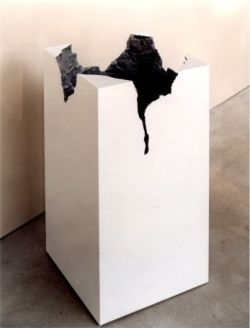
James Casebere
James Casebere: Since the 1980s, James Casebere’s photographs have transported viewers
into ambiguous, evocative, and surreal environments. Casebere’s process
involves constructing tabletop models out of modest materi¬als, such as
Styrofoam, plaster, and cardboard. He then dramatically lights these
constructions and care¬fully positions his camera to manipulate the
com¬position and the mood of the resulting photograph. Devoid of human
figures, the constructions invite viewers to project into and inhabit
the space. (From the 2010 Whitney Biennial website)
David Park
David Park (1911–1960) is one of those artists who isn’t widely known but whose work inspires a special loyalty and warmth of feeling among his admirers. The partisan flavor his very name can arouse is partly dependent, of course, on his not being a household name to begin with. But Park, who was based in Berkeley, California, and was, along with Richard Diebenkorn and Elmer Bischoff, one of the leading lights of what has been called “Bay Area” painting in the 1950s, makes some of us always eager to see more of his work and learn more about him because his best pictures have a particular tenderness and sense of gravity—a note that sets him apart from near-contemporaries of his such as Alice Neel, Fairfield Porter, or Alex Katz. (From the web)
Matthew Monahan
Matthew Monahan’s work presents a futuristic archaeology. Drawing from a wide range of influences, from Modernist art to ancient totems, Monahan’s ‘artefacts’ are both familiar and strange. Filtering historical mythologies through his own personal system of reference, altered further through the experience of making, Monahan’s work alludes to a contemporary spirituality, where beauty and brutality coalesce as virtual monuments. In Riker’s Island, Monahan adorns his vitrine with hand-crafted ‘relics’. Nondescript and clunky, their plausible function is secondary to their materiality: wax, paper, and plaster take on barbaric forms, their temporal media humorously suggesting timelessness. Their precious value is guarded by an over-sized sculptural ‘shard’: a monolithic goddess modernised and flat-packed in 2 dimensional card. Through his assemblages, Monahan offers a dark mysticism, where material trickery and abstracted form resurrect forgotten primal instincts. (note: from the Saatchi Gallery website)
Thomas Houseago
Thomas Houseago’s figurative sculptures appear physically imposing and powerful in their size and positioning yet fragmented and vulnerable in their construction. To build these works, Houseago begins with a structure of iron rods and then adds a variety of traditional sculptural materials such as plaster, hemp, and wood. Some of his works incorporate graphite or charcoal sketches of faces and anatomy on plaster and wood panels.
Monstrous yet unthreatening, this work— a part-human, part-animal being—is in a transitional pose between walking and crawling, weighted on the flat expanses of its plaster hands and feet. Houseago’s combination of sculpting and drawing challenges conventional aesthetic boundaries between three-dimensionality and flatness, monumentality and spontaneity. (from the 2010 Whitney Biennial website)
A few new friends: Huma Bhabha
Huma Bhabha: Assembled from mundane materials and scraps of detritus, Huma Bhabha’s My Skull Is Too Small resembles an array of masks or totems. Abstracted fragments of human features—eyes, ears, and legs—coalesce uneasily, as if they are still in the process of being formed or already in a state of decay. The sculpture’s stylized composition and areas of roughly worked clay evoke archaic monuments ravaged by time. Yet the tangled chicken wire and spraypainted Styrofoam blocks that protrude beneath the clay surfaces locate the piece in the present or even in some imaginary dystopian future. The pedestal of this work, with its graffiti marks and collage elements, suggests a shipping crate. Bhabha often describes her sculptures as “characters” that project psychological depth through traces of violent use and references to the history of figurative sculpture. Although the distressed materials in her work can allude to catastrophe, they also convey a paradoxical sense of renewal. (From the 2010 Whitney Biennial website)
Sunday, July 22, 2012
mB Artist.10.11.12
tres Artistas
uno.Tomás Saraceno
 |
| Tomás Saraceno, 14 Billions (working Title), 2010. Photo: Studio Tomás Saraceno |
Recommended to me by Denise, Argentinian Artist currently showing at the Met.
dos.Joseph Kosuth
 |
| View of “The Mind’s Image of Itself #3, a play of architecture and the mind,” 2011. |
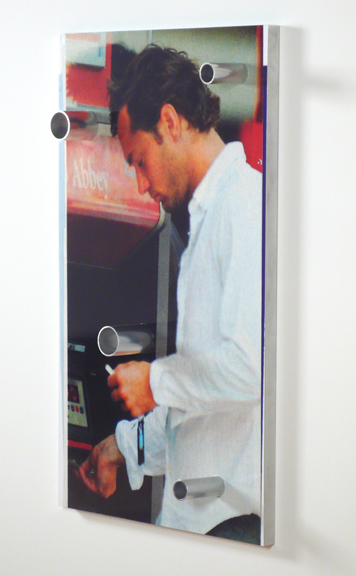 |
| Nobody Ever Said It Was Going to Be Easy, 2008 |
So true...
5 Artists, Week of July 23
1. Alghierro Boetti
2. Andrea Zittel
I saw her work in MOMA's permanent contemporary collection. I think I'm in love.
Go here to see Art21's video about her: http://www.pbs.org/art21/artists/andrea-zittel
Saturday, Season 1 artist Andrea Zittel opens her inaugural “smockshop” at Susan Inglett Gallery, coinciding with Fashion Week in New York.
Having spent years gaining international recognition and developing a variety of concepts for living, from furniture manufacturing, A-Z Administrative Services to the design and construction of an island off the coast of Denmark, A-Z Pocket Property, Zittel returns to the gallery as fashion arena with smockshop. With the collection that consists of a series of smocks sewn and designed in cooperation with various artists, Zittel challenges the connection between fashion and function, design and life, and commerce and art, and makes these links explicit by selling her one-of-a-kind smocks at ready-to-wear prices. (Art21 Blog: http://blog.art21.org/2007/09/06/liberation-through-limitation%E2%80%94andrea-zittel%E2%80%99s-smockshop/)
See the smock shop at www.smockshop.org
2. Andrea Zittel
I saw her work in MOMA's permanent contemporary collection. I think I'm in love.
Go here to see Art21's video about her: http://www.pbs.org/art21/artists/andrea-zittel
Having spent years gaining international recognition and developing a variety of concepts for living, from furniture manufacturing, A-Z Administrative Services to the design and construction of an island off the coast of Denmark, A-Z Pocket Property, Zittel returns to the gallery as fashion arena with smockshop. With the collection that consists of a series of smocks sewn and designed in cooperation with various artists, Zittel challenges the connection between fashion and function, design and life, and commerce and art, and makes these links explicit by selling her one-of-a-kind smocks at ready-to-wear prices. (Art21 Blog: http://blog.art21.org/2007/09/06/liberation-through-limitation%E2%80%94andrea-zittel%E2%80%99s-smockshop/)
See the smock shop at www.smockshop.org
Other miscillaneous artists
3. Cardboard Institute of Technology - a group of cardboard artists
4. Barbara Schulman - textile artist, Kutztown, PA
5. Marianne Jorgensen
Weekly post
I got introduced to a few interesting artists this week during my crit with Eileen Neff.
John Stezaker was a British artist who could be described as a conceptual, surrealist collagist.
Dressy Hiking Shoes
“For me it was something I always wanted to do: draw a five-mile line on a city map and mark it as a trail. The trail had to be an interesting cross-section, showing the transportation, highway, electric infrastructure of the city. I always wanted to find the area between the urban and the suburban, the first patch of homeowner’s lawn.”
John Cage
John Stezaker was a British artist who could be described as a conceptual, surrealist collagist.
Mask XXXV
Mask XXIX
James Gallager is a contemporary collagist. From his bio:
James Gallagher uses collage to investigate human form and personal identity. Piecing together images cut from discarded books, forgotten issues of National Geographic, and the occasional vintage sex-manual, Gallagher creates stark and provocative scenes that reflect the world around him.
Guyton Series 4 / 2011 / 10"x10"
Threads / 2010 / 4"x6"
Mark Bradford is a comtemporary artist from L.A. who makes collage and décollage from found material, as well as video installations. His stuff seems like it would be awesome to see up close and in person.
This video is definitely worth checking out: Mark Bradford Art 21
Susan Hiller is another contemporary artist, but she is not amonst the collagists. Her work seems to be all over the map, from 2-D prints reminiscent of Andy Warhol, to sculpture, to installation, video, and on and on. She was recommended to me by Eileen as an anthropological artist.
Her website is worth a visit: http://www.susanhiller.org/
Red
"We live in a world of lost meanings. Journey to the Land of the Tarahumara explores my preoccupation with the undecipherable signs transmitted to us by extinct cultures, signs scattered around the world that now exist solely in material form as if they were empty shells. The title of the series evokes the hallucinatory journey made by Antonine Artaud, surrealist poet and playwright, to the secluded and little-known Tarahumaran people of Mexico in 1936. On my own travels around the world I've looked for and photographed 'mysterious symbols' engraved on rocks by earlier cultures. The images in this series are the result of rethinking and re-presenting those symbols as configurations of prints that directly illustrate their power. These works record my personal meditation on remnants, fragments and lost meanings. "
Homage to Yves Klein: Levitations 2008
Finally, a famous surrealist artist who I like, who did collage and saw some of his work at the MoMA last week: Max Ernst.
His surrealist collage novel "Une Semaine de Boite" ("A Week of Kindness) is excellent. I recommend it if you think you might be interested in it.
News and art articles:
Berlin conceptual artist Christian Jankowski travels to Dubai to meet curator and artist Rami Farook, to work together for the BBC's Collaboration Culture project.
Over three days Farook guides a blindfolded Jankowski through the souks and the desert, the artificial snow mountain and the hectic streets, while they make a film of their journey together.
Dressy Hiking Shoes
“For me it was something I always wanted to do: draw a five-mile line on a city map and mark it as a trail. The trail had to be an interesting cross-section, showing the transportation, highway, electric infrastructure of the city. I always wanted to find the area between the urban and the suburban, the first patch of homeowner’s lawn.”
John Cage
So, don’t be caught with your pants down in front of some inexplicable wall full of squiggles: Not only will you get arrested (umm…maybe) but you’ll look like a schmuck.
Subscribe to:
Comments (Atom)



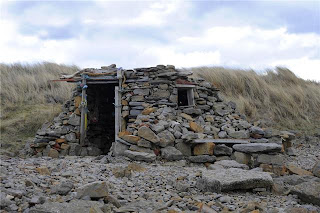


















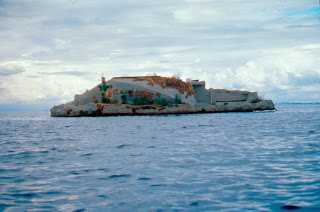










%2520XXIX%25202007.jpeg)


